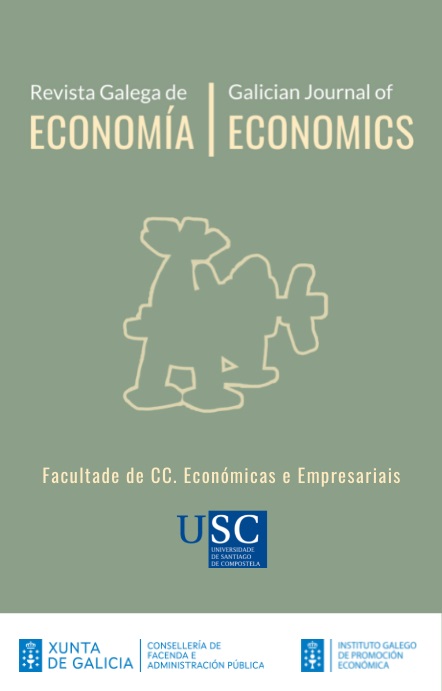MACROECONOMETRIC STABILIZATION AND IMF POLICIES: A SURVEILLANCE OF INFLATION
Contido principal do artigo
Resumo
between aggregate money supply and changes in the general price level (inflation) for a
selected group of countries with historically stable prices and episodes of very high inflation.
Recent paradigmatic shifts from exchange-rate-based stabilization policies to
conditionalities involving price stability have greatly influenced the empirical work of this
paper. Empirical results indicate that the money supply and inflation are cointegrated in
some countries with high spells of inflation, such as Argentina, Brazil, and Mexico, but that
the variables may not be cointegrated with each other for countries with prices that are
generally and historically stable, such as the UK and the US. The paper highlights the need for
good quality governance, employment, and productivity in surveillance measures that are
designed to obtain external balance.
Palabras chave
Detalles do artigo
Citas
Berg, A., Charry, L, Portillo,R., and Vlcek, J. (2013). “The Monetary Transmission Mechanism in the Tropics: A Narrative Approach,” IMF Working Paper 13/197. Washington DC: International Monetary Fund.
Blejer, M., Leone, A.M., Rabanal, P., and Schwartz, G. (2002). Inflation Targeting in the Context of IMF Supported Adjustment Programs. Norman Loayza and Raimundo Soto (Eds.), 5, 439-64.
Central Bank of Chile. Caballero, R.J., Farhi, E. and Gourinchas, P.O. (2008). “An Equilibrium Model of ‘Global Imbalances’ and Low Interest Rates” American Economic Review, 98(1), 358-93.
Ciobanasu, I.C. (2012). “Expanded Mandate for the IMF: Global Financial Stability [Legal Implications for the Articles of Agreement]” Minnesota Journal of International Law Online, 21, 130-160.
Eichengreen, B., Hausmann, R., and Panizza, U. (2005). The mystery of original sin. In Other people’s money: Debt denomination and financial instability in emerging-market economies, ed. Barry Eichengreen and Ricardo Hausmann, 233–65. Chicago: University of Chicago Press.
Goyal, R., Marsh, C., Raman, N., Wang,S., and Ahmed, S. (2011). “Financial Deepening and International Monetary Stability.” International Monetary Fund, SDN/11/16.
Gourinchas, P.O., and H. Rey, H. (2005). “From World Banker to World Venture Capitalist: U.S. External Adjustment and the Exorbitant Privilege,” NBER Working Paper No. 11563 Cambridge, MA: National Bureau of Economic Research.
King, R.G. and Levine, R. (1993). “Finance and Growth: Schumpeter Might be Right.” Quarterly Journal of Economics, 108(3), 717-37.
Krueger, A.O. (1984). Exchange-Rate Determination. New York, NY: Cambridge University Press.
Lastra, R.M. (2011). “The role of the IMF as a global financial authority.” European Yearbook of International Economic Law, 2.
Mankiw, G. N. (2013). Macroeconomics. New York, NY: Worth Publishers.
Mishra, P, and Montiel, P. (2012). “How Effective is Monetary Transmission in Low-Income Countries? A Survey of the Empirical Evidence,” IMF Working Paper 12/143. Washington DC: International Monetary Fund.
Rajan, R.G., and Zingales, L. (1998). “Financial Dependence and Growth.” American Economic Review, 88(3), 559-86.
Saner, R. and Guilherme, R. (2007). “The International Monetary Fund’s Influence on Trade Policies of Low-Income Countries: A Valid Undertaking?” Journal of World Trade, 41(5), 931-981.
Siegel, D. E. (2002) “Legal Aspects of the IMF/WTO Relationship: The IMF’s Articles of Agreement and the WTO Agreements,” American Journal of International Law, 96(3), 561-621.
Lane, C., Pattillo,C., Opoku-Afari, M., Arena, M., Unsal, F., Ndela Ntsama, N., Davoodi, H., Portillo, R., Laurens, B., O’Connell, S. Maslova, S. and Jahan, S. (2014). “Conditionality in Evolving Monetary Policy Regimes.” Approved by Siddarth Tiwari. International Monetary Fund. Washington, DC.
Mussa M (1997) IMF Surveillance. The American Economic Review, 87(2): 28-31. Mussa, M. (2007). “IMF Surveillance over China’s Exchange Rate Policy.” Peterson Institute for International Economics.
Mussa M, Savastano M (2000) The IMF Approach to Economic Stabilization. In NBER Macroeconomics Annual 1999, vol.14. Bernake, B. S. & Rotenberg, J.J. (Eds.). Cambridge, MA: The MIT Press.
Papageorgiou, C., Ho,G., Wang, K., Gigineishvili, N., Pitt, A., Choi, T.S., Duma, N., Rosa, S., Henn, C., Eicher, T., and Kuenzel, D. (2014). “Sustaining long-run growth and macro stability in lowincome countries: the role of structural transformation and diversification—background notes.” Approved by Siddharth Tiwari. International Monetary Fund. Washington, DC.
Quantitative Micro Software (2009). Eviews 7. Irvine CA: Quantitative Micro Software.
Sahay, R., Towe, C. Marston, D. Claessens, S., Blancher, N., Hamann, J., Holland, A., Morsink , J., Maechler, A, and Stuart, A. (2012). “The IMF’s Financial Surveillance Strategy.” Approved by José Viñals, Siddharth Tiwari, and Olivier Blanchard. International Monetary Fund. Washington, DC.
Salvatore, D. (2010). International Economics 10th ed. Hoboken, NJ: John Wiley and Sons.
Warburton, C.E.S. (2012). The Delicts and Criminal Laws of International Economic Relations. New York, NY: McGraw Hill.
Warburton, C.E.S. (2014). “Time Dynamics of Stabilization Theories and Responses to Debt and Financial Crises.” Applied Econometrics and International Development, 14(2).
Warburton, C.E.S. (2013). “When Markets Fail: Asset prices, government expenditures, and the velocity of money.” Applied Econometrics and International Development, 13(2), 73-92.
Weiss MA (2013) International Monetary Fund: Background and Issues for Congress. Congressional Research Service, R42019, 1-29. World Bank (2014). World Development Indicators. Washington, DC: World Bank.






